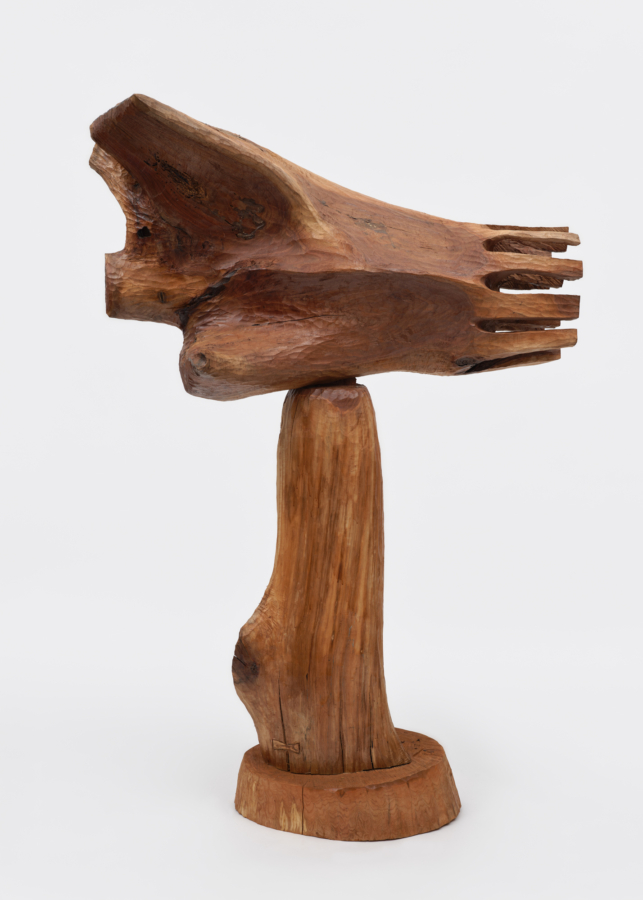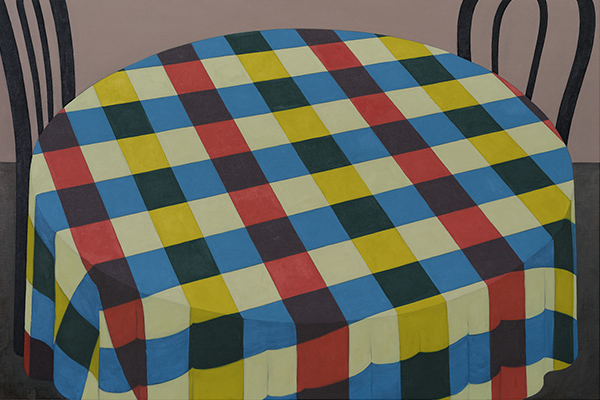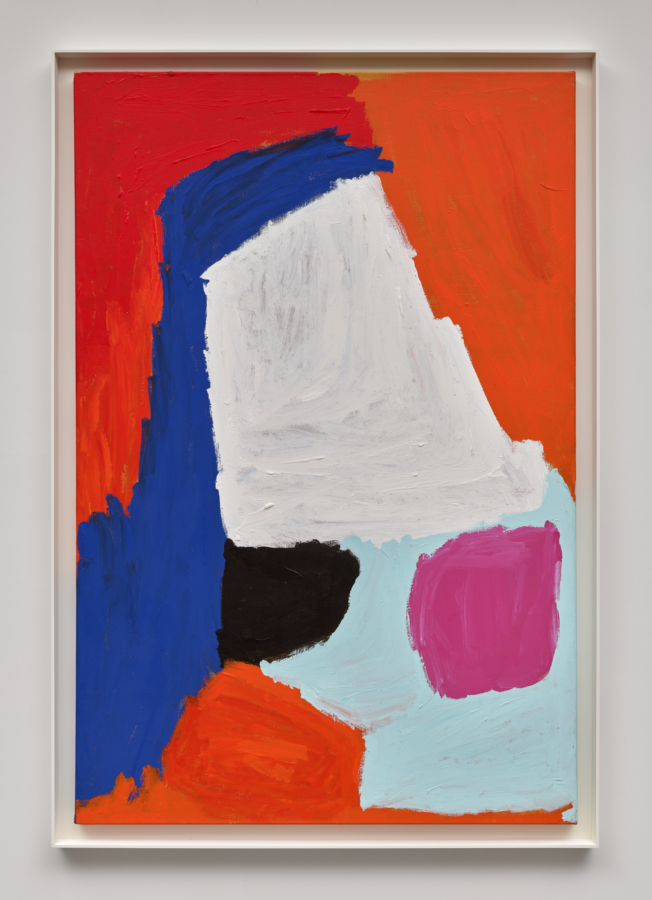Spring 2004
Crossing Currents: The Synergy of Jean-Michel Basquiat and Ouattara Watts, Hood Museum of Art, Dartmouth College, Hanover, New Hampshire, 2004.
SYNCRETISM IN ART
Since the nineteenth century, indigenous African religions, philosophies, and cultural practices have made their way across the Atlantic, assisted by colonialism, the trans-Atlantic slave trade, and more recently immigrants, refugees, and postcolonial migrants. Similarly, Islamic and Christian-based proselytization in Africa has engendered a corresponding fusion of religious and cultural practices throughout the continent. On both sides of the Atlantic, this blending of African, Western, and Middle Eastern traditions has led to the development of new artistic expressions informed by the accretive and coalescent processes of syncretism.
In the West, syncretism is most commonly associated with the merging or unification of several, often disparate, traditions of reli- gion and mythology. However, the adaptive process of syncretism results also in the merging of other cultural systems, such as philosophy and art. In the latter case, the syncretic process leads to the creation of multiple, and frequently new, interpretations and meanings for particular works of art. Since this process negotiates and even vacillates between different cultural systems, it inevitably produces a heterogeneous yet unique mix of ideas, beliefs, and practices, made up of both familiar and extrinsic parts. Ultimately, the newly adopted forms remain related to, but are also fundamentally changed from, their origins.
Since syncretism is ultimately associated with communication, it can find its way into the arts through the artist (the sender) or the viewer (the receptor) of the visual message. In some cases, the artist unconsciously introduces syncretic elements into the work, reflecting only his or her internalized sensibilities. In other cases, such as in the work of Ouattara Watts, the artist consciously introduces syncretic elements into the work to imbue it with relevance that speaks to a broader and more diverse cultural audience. In his paintings, Watts presents the viewer with a visual language that is rooted in the process of syncretism as also in his friendship early in his career with the African American artist Jean-Michel Basquiat.
OUATTARA WATTS
Ouattara Watts is probably the first African artist to attain international fame within the arena of contemporary art. Born in 1957 in Cote d’Ivoire, Watts oscillates between the traditional setting of his hometown of Korhogo, the urban environment of the nation’s capital in Abidjan, and the international art worlds of Paris and New York. Through painting, Watts quietly reflects upon his African up-binging, his spiritual sensibilities, and his cultural heritage. However, his art responds also to broader sociocultural, spiritual, and transnational exchanges that were prompted by his move to New York in 1988 with the support of his friend Basquiat.
As an artist, Watts maintains a close relationship with the materiality of his art. He makes his own paint from acrylic medium and pigments, often mixing in organic materials such as earth, wood shavings, or coagulated droppings from other paintings to create a pasty, rough surface on the canvas. In his earlier work, Watts covered this surface with rich earth tones reminiscent of his African homeland: browns, ochers, muted yellows, black, indigo blue, and deep reds. However, after he moved to New York, Watts extended his color palette to include electric oranges, yellows, purples, and blues, endowing the canvas with a new vibrancy and internationalism.
In the past, Watts often demonstrated a flair for rummage, reuse, and improvisation, attaching found objects–mundane mementos from his Western life–to his large canvases and thereby invoking a deeper significance for them: a skateboard became a vehicle for spiritual travel from one realm of the world to another; jumper cables served as a potent source for the transmission of energy; and photographs revealed fragments from the artist’s life, uniting him with the analogous experiences of the viewer. In Watts’s most recent series of works, featured in this exhibition, he attaches strips of boldly designed textiles to the canvas, scattering its surface with cryptic cultural ideograms that represent a blend of African, Diasporic, Western, and Eastern religious symbolism. Watts offsets this visual syncopation with floating abstractions and twisting propeller shapes that appear as saturated accretions of color bursting out of the picture plane.
Playing with the multilayered quality of his paintings, Watts also juxtaposes his material and symbolic signifiers with linguistic, numeric, and scientific notations. Many of these markings remind his audience more immediately of today’s Western technophilic world than of an African cultural context. As Watts notes, “Presently in Africa, people are connected to technology…They also watch television, listen to the radio. My life is very much the same way–I cannot say that I went to the [Senufo] spiritual school and limit myself to only talking about that experience. My experience, good or bad, also includes Western-style education, which cannot simply be ignored. I try to make a synthesis of both experiences” (quoted in Enwezor 1995:28). Western viewers can easily associate Watt’s color sensibilities and use of found objects with abstract expressionism, Schnabelesque influences, Rauschenberg’s “combines,” or graffiti art. Indeed, Watts speaks of the pivotal impact that his Western formal training had on his early artistic development, especially the works of artists such as Jackson Pollock, Cy Twombly, and Joseph Beuys. However, after 1988, Watt’s friendship with Basquiat, who was first known for his graffiti art and then for his multicultural visual language, had a considerable impact on his artistic development and fusion of African and Western expressions into an encoded visual language.
Watts’s use of recycled materials is closely connected also to his Cote d’Ivoire artistic predecessors, specifically to the art movement called Vohou-Vohou, which flourished at L’Ecole des Beaux Arts d’Abidjan in Cote d’Ivoire between 1968 and the 1980s. Prompted by the rarity and high price of Western imported art materials in the 1960s, artists in Abidjan were forced to recycle local materials into their art works, investing them with new surfaces, tactility, and materiality. In its use of both local and imported forms and materials, this art movement created a new vocabulary of idioms based on both African and Western origins.
Despite their cultural relevance to Vohou-Vohou arts, however, Watts’s paintings transcend this local Abidjan movement. His work maps out the geographic, religious, and cultural borders he has crossed, fusing the common currents that flow between them. Watts culls may of his symbols from his African religious heritage, embedding into his work recurring motifs from his own Senufo religion of Cote d’Ivoire; Banana masks and Dogon checkerboard patterns from Mali; the double ax 9or propeller form) of Shango, the thunder god in the Yoruba religion of Nigeria and Afro-Caribbean syncretic religions; and and imagery from ancient Egypt. Art for Watts is all about spirituality, cosmos, concept, and energy; it is about communicating with and about the invisible; it is about creating a universal language with symbols and signs that cross the margins of geographic, national, and cultural boundaries. Hence, Watts draws from his own experiences as a transnational artist seeking community in shared world philosophies. Many of the African symbols he uses in his painting–such as the snake, skull, cruciform, crescent, hand, horn, spiral, ad concentric circles–find their equivalents also in Christian, Judaic, and Muslim religions.
Like the religious idegrams of his work, Watts’s numeric notations refer to a variety of African divination systems. These include the ifa system of the Yoruba peoples of Nigeria and geomantic devices such as the healing squares and Qur’anic tables of the West African Sufi movement. Yet the African origins of these notations should not be overemphasized, as the symbols relate also to cabalistic, astronomic, and mathematical computations and language systems of Western religious, scientific, and technological domains. This confluence of science and technology with religion is clearly present in Watt’s newest additions to his inventory of icons–the atom and binary computer language–which invoke the flow of energy, force fields, mystery, discovery , and global communication systems. Like chemical alloys, the seemingly incoherent compositional elements in Watts’s paintings fuse with each other, generating multilayered and multicultural messages of spirituality and force.
Watts’s indirect and direct experiences of colonialism, spirituality, and globalism place him in the center of today’s transnational art world, whose inhabitants find refuge rather than ghettoization in hybrid identities. The ease with which he negotiates his own multiple identities within this art world starkly contrasts with the difficulty that artists of multicultural backgrounds, such as Basquiat, encountered during the 980s. Unlike Basquiat, who struggled to align his own multicultural identity within the white-dominated international art scene of the 1980s, Watts is as comfortable in today’s transnational world as he is in his Cote d’Ivoirian hometown. And yet it is precisely because of Basquiat’s cultural breakthrough in the international art worlds of Europe and America that the doors were opened to artists from other parts of the world, such as Watts, whose artistic and personal development embodies the memory and influences of Basquiat’s legacy.
JEAN-MICHEL BASQUIAT
Jean-Michel Basquiat was one of the most famous African American artists of the twentieth century. Born in 1960 in Brooklyn to a Haitian father and a Puerto Rican mother, Basquiat emerged on the international art scene in I981 from the multi- ethnic subcultures of New York’s street life. Throughout the 1980s, he spent much of his abbreviated career in search of a sense of cultural and artistic community within the New York and international art scenes.
Basquiat began publicly expressing his artistic and lyrical talents by painting graffiti in the streets of Soho during the late I970s under the name of SAMO©. But by 1981 he had penetrated New York’s art scene, finding refuge with the top European and American artists of the neo-expressionist and pop art movements of the 1980s, including Francesco Clemente, Andy Warhol, and Keith Haring, among others. Through these artists, Basquiat sought guidance and support in a scene dominated by white male artists, art dealers, and collectors. Yet he also sought community with important African American, Hispanic, and Caribbean visual and performing artists such as Fred Braithwaite (a.k.a. Fab Five Freddy), James Van Der Zee, Ramm-El-Zee, Afrika Bambaata, members of the Zulu Nation, Lee Quinones, and Shenge Kapharoah. Through these leading figures of New York’s subcultures, Basquiat came into direct contact with the city’s cultural syncretism, while also feeding his desire to connect with the black experience and Afrocentric themes that were excluded from the predominately white New York art scene.
Basquiat was known for his insatiable hunger for knowledge, language, and linguistic signs, which he nourished through his interests in hip-hop, jazz, drugs, popular culture, anatomy, world religions, and cultural histories. But he also collected and studied African and Diasporic art, culture, and mythology. This played an important role in the development of his symbolic cues, which—as in Watts’s work—included African masks, figurative forms, and religious symbols such as the snake, skull, arrow, leopard, and staff.* As art critic Bell Hooks has stated, “Rarely does anyone connect Basquiat’s work to traditions in African American art history. While it is obvious that he was influenced and inspired by the works of established white male artists, the content of his work does not neatly converge with theirs. [. . .] It is the multiple other sources of inspiration and influence that are submerged, lost, when critics are obsessed with seeing him solely connected to a white Western artistic continuum. These other elements are lost precisely because they are often not seen, or if seen, not understood” (1993: 70). Susanne Reichling asserts that Basquiat’s interest in African art and culture formed the center of his self-definition as an African American artist, enabling him to construct a positive black identity despite his central though turbulent position in the white male-dominated art world of the 1980s (1998: 76).
Basquiat’s search for identity led him directly to reconnect with and reconstruct his African and Diasporic heritage. For Basquiat, Africa promised the repossession of a lost culture and the construction of a trans-Atlantic vocabulary that expressed a new, positive African American consciousness. Hence, in 1986 Basquiat went on an artistic pilgrimage to Abidjan, Cote d’lvoire, where he exhibited his paintings in hopes of meeting African artists whose sensibilities resonated with his own. Disappointed with the artists of the Ecole des Beaux Arts in Abidjan, who were working in Western art traditions, Basquiat traveled to Korhogo in northern Cote d’lvoire to study local spiritualism. Unbeknownst to the artist, Korhogo was the hometown of Ouattara Watts, who was an emerging artist living in Paris at that time. Basquiat’s fortuitous journey to northern Cote d’lvoire played a key role in initiating a friendship between these two men when they finally met in Paris at the beginning of 1988.
A SYNERGISTIC ENCOUNTER
While exhibiting his work in Paris, Basquiat encountered and immediately befriended Watts. He was impressed by the dynamic power of Watt’s paintings and their shared interest in African cultures, world philosophies, symbolic systems, and spirituality. This newfound sense of community sparked an artistic kinship that led Basquiat to convince Watts to move to New York, where in the ensuing months they conversed about Africa and African cultural practices, discussing African sacred arts, visiting the Voodoo Museum in New Orleans, and traveling to the Mississippi Delta region to discover more about the history of slavery in America. The two artists also had plans to travel to Cote d’Ivoire together to find refuge and community in Watts hometown in Korhogo and to create collaborative paintings that fused their related yet different syncretic languages. But on August 12, 1988, Basquiat died of a drug overdose.
In spite of the tragic and premature end to the two men’s friendship, their artistic kinship continued to impact Watt’s life. During their time together, Watts had helped to endow his American friend with a deeper understanding of African spiritualism and symbolism. Basquiat In turn had supported Watts in his early days in New York, introducing him to art circles that had remained until then virtually impenetrable to contemporary artists from outside the Euro-American art world. Under Basquiat’s aegis and the legacy of their brief but intense friendship, Watts came of age in New York City and entered the elite ranks of the glocal art world in 1989, when he was given a solo exhibition at Vrej Baghoomian Gallery. After Basquiat’s death, Watts’s painting style changed from a transparent regional African expressionism into an opaque international style that resonated with his friends’ multilayered dialect. Like Basquiat, Watts began using coded visual cues based on syncretic ideograms that opened his work to multiple interpretations, especially when viewers attempt to interpret the message from within their own worldviews. By recognizing certain elements and then placing them within a familiar cultural context the viewer can decipher the message or assign meaning to the artwork on his or her own terms. Therefore, depending on the contextual framework from which it is read, the viewer’s understanding of the work may or may not necessarily coincide with the artist’s intention, which makes Watt’s dialect–like Basquiat’s–even more dynamic and predisposed to layered interpretation. As such, Watt’s work not only synthesizes his own multicultural experiences but also embraces the viewer’s syncretic sensibilities. Through his work, Watts has created the artistic locus that he and Basquiat had hoped to discover in 1988, continuing their mission to develop a visual language that speak about and to synergistic perspectives where cultural boundaries and social identities can be freely and continuously redefined, reconstructed, and reinterpreted.



